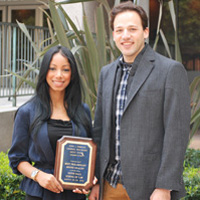3Ls place first and second in national competition
Although she’s quick to point it out, few people would notice the scratch on the blue-and-gold plaque Amanda Murray ’12 brought home with her on the flight from Newark, N.J., last month.
 |
| Amanda Murray & Michael Parente photo by Lori Craig |
Then again, most people don’t subject themselves to the level of scrutiny that Murray and co-counsel Michael Parente ’12 faced during their oral arguments at the John J. Gibbons Criminal Procedure Moot Court Competition, held last month at Seton Hall University School of Law.
Representing USC Law, Murray won best oralist and Parente won second-best oralist for the preliminary rounds of the competition, which featured 42 teams and more than 84 competitors from law schools across the country, arguing cases on appeal before a mock United States Supreme Court.
Semifinalists at last year’s USC Law Hale Moot Court Honors Competition, Murray and Parente say they enjoyed the experience and welcomed the opportunity to sharpen their skills while competing with advocates from other law schools.
“I really enjoy arguing cases before judges, and I thought it would be interesting to see the differences between what we’re taught here and what’s emphasized at other programs across the country,” Murray says.
Parente, who has been a law clerk with the federal public defender’s office and who seeks a career in criminal law, says he felt similarly.
“The opportunity to argue on your feet in a case before the Supreme Court is a unique challenge,” he says. “This competition seemed like a natural extension of the Hale Moot Court program.”
Although Murray will be working in corporate law—not litigation—after she graduates, she says that the skills required to excel at moot court are applicable to transactional law.
“I feel that the skills translate into negotiating deals, because all you’re doing is presenting your arguments to someone who is evaluating them,” she says. “That’s going to help me succeed in whatever I do.”
Although the Gibbons Moot Court Competition, like many national moot courts, allows up to five members per team, including a coach, three oralists, and a brief writer, USC Law typically sends teams of two students each to national competitions. This arrangement requires that each student argue both sides of the case in addition to writing the brief.
Prof. Rebecca Lonergan, who directs the Hale Moot Court Honors Program, coaches all five teams that compete nationally. Murray and Parente say that she trains advocates to answer questions directly and to prepare for a “hot bench”—one in which the judges frequently interrupt with questions.
“Some say Moot Court is about style, but the substance is driving the style,” Parente says. “If you don’t have the substantive arguments down, you’re much more likely to get pinned during the argument and then demonstrate a poor style.”
Murray says it’s important to have complete confidence, which you can attain only with rigorous preparation.
“The confidence is predicated on preparation,” she says. “You need to be well-researched, know the record, know the issues and know what you’re talking about.”
Both oralists say the best moot court arguments have the feel of a conversation.
“You don’t want it to feel adversarial,” Parente says. “There’s something inherently adversarial and competitive about it, but ideally you want your argument to come across like you’re just sharing information with the judges.”
“And if you can have that conversation with the judges, you can have it with a senior associate or partner at a firm,” Murray says. “You really are confident when you have the substance and you have researched, and your arguments are supported by case law.”
Parente says it also helps to find something in the case you’re “extra passionate” about.
“Whether it’s something about the defendant or a rule you know to be right, it helps if you can find that,” he says.
After working together for a month before the competition, Murray and Parente each have learned something about the other’s moot court style.
“If I had to describe Amanda in one word, it would be ‘unflappable,’” Parente says. “She is very smooth, her demeanor is superb and she is direct and precise when answering questions.”
“Michael is very calm in his tone—he puts you at ease,” Murray says. “He’s able to have a conversation with the judges. And he’s very thorough when articulating the intersection of his arguments with the case law to the judges.”

















